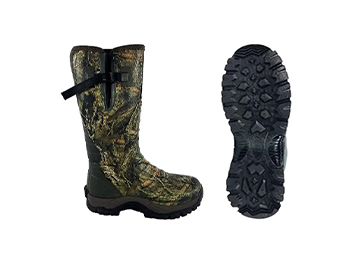How to Choose Hunting Boots
Choosing the right pair of hunting boots is essential for any serious hunter. The right boots can significantly impact your comfort, safety, and overall hunting experience. Here's a guide to help you navigate the various options available.
1. Consider the Terrain
The type of terrain you'll be hunting in is one of the most critical factors in selecting the right boots. For rugged, rocky conditions, you’ll want boots with good ankle support and a sturdy sole. If your hunting grounds are marshy or muddy, waterproof boots with good traction are a must to prevent slipping and to keep your feet dry.
2. Assess the Weather Conditions
Weather can change rapidly in the wild, so it's essential to choose boots that can withstand the conditions. If you’re hunting in colder climates, insulated boots will keep your feet warm. Look for options with materials like Thinsulate or other insulating technologies. For warmer climates, breathable materials are crucial to avoid overheating and sweat buildup, which can lead to discomfort or blisters.
3. Fit and Comfort
A good fit is paramount when it comes to hunting boots. Ill-fitting boots can lead to blisters, foot fatigue, and can hinder your ability to move quickly or quietly. When trying on boots, wear the socks you intend to wear while hunting to ensure a proper fit. Make sure there's enough room for your toes and that the heel doesn’t slip while walking.
how to choose hunting boots

The weight of your hunting boots can affect your mobility and stamina. While heavier boots offer added protection and insulation, they can also tire you out quickly, especially during long treks. Look for lightweight options that still provide the support and protection you need, particularly if you’ll be on the move for extended periods.
5. Material Choices
Hunting boots come in various materials, each with its benefits and drawbacks. Leather is durable and water-resistant but can be heavy and less breathable. Synthetic materials, on the other hand, are often lighter and more breathable, making them suitable for different weather conditions but may not offer the same level of durability as leather.
6. Traction and Outsole
Good traction is crucial for a successful hunt. Look for boots with deep lugs on the outsole that provide grip on different terrains, whether you’re climbing steep hills or navigating through mud. Vibram soles are a popular choice for their durability and excellent traction.
7. Features and Accessories
When shopping for hunting boots, consider additional features like reinforced toe caps for protection, gaiters for added waterproofing, and insulation for warmth. Some boots also come with removable insoles for added comfort and support, which can be a valuable feature during long days in the field.
Conclusion
Choosing the right hunting boots is more than just style; it’s about ensuring your comfort and safety during your time in the wild. By considering the terrain, weather, fit, weight, materials, traction, and additional features, you can make an informed decision that will enhance your hunting experience. Invest time in selecting the right pair, and it will pay off in the field, allowing you to focus on what really matters—hunting successfully.
-
Stay Dry in Any Condition with WadersNewsJul.17,2025
-
Elite Performance with Camouflage Combat BootsNewsJul.17,2025
-
Dry and Comfortable with Green Rubber Garden ShoesNewsJul.17,2025
-
Convenient Protection with Foldable RainbootsNewsJul.17,2025
-
Comfort and Protection with Neoprene Work BootsNewsJul.17,2025
-
Brighten Rainy Days with Floral Rain BootsNewsJul.17,2025
-
Safety Wellies: The Ultimate Combination of Protection, Comfort, and VisibilityNewsJun.19,2025











